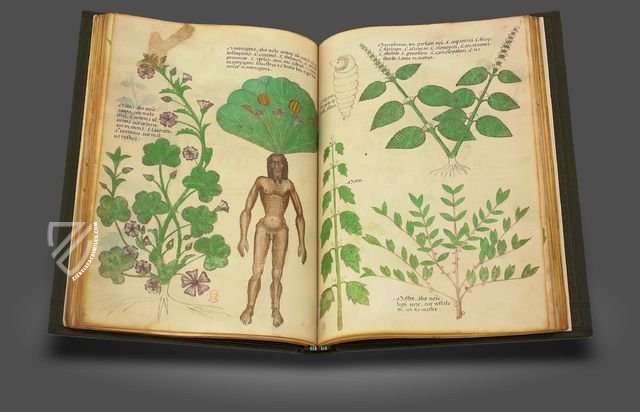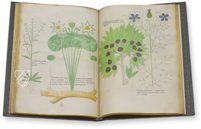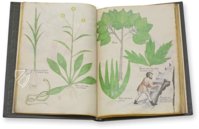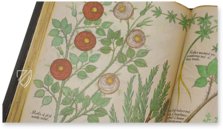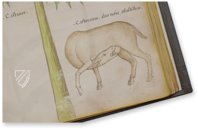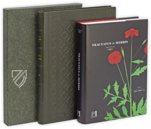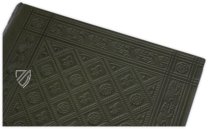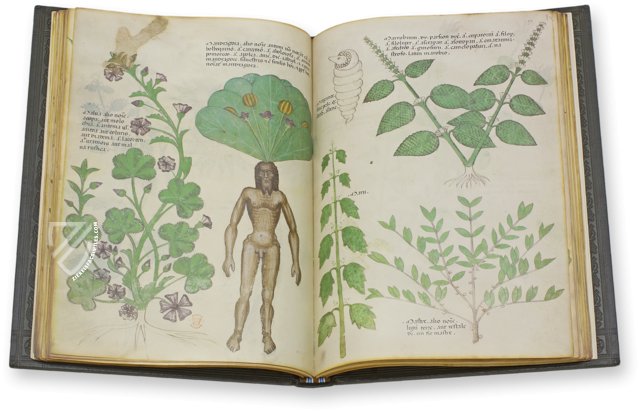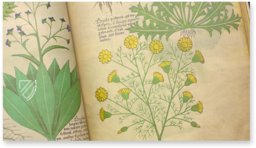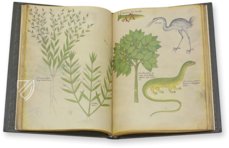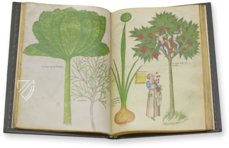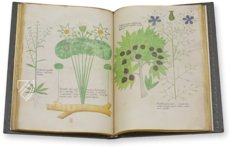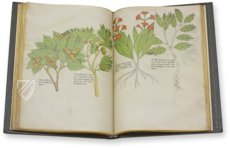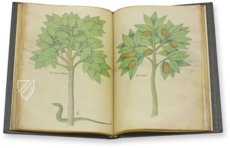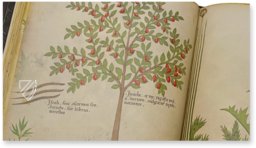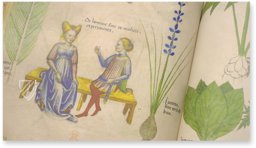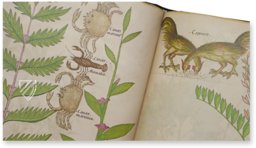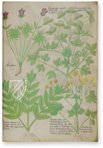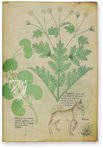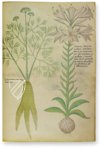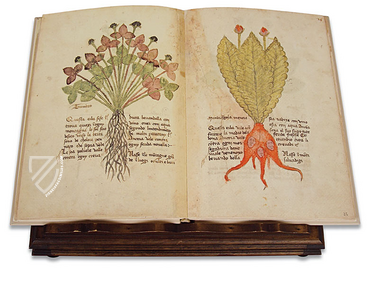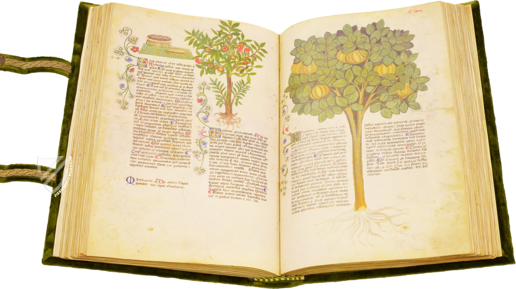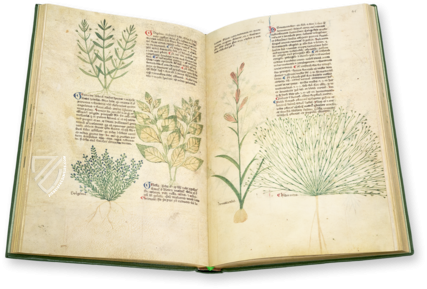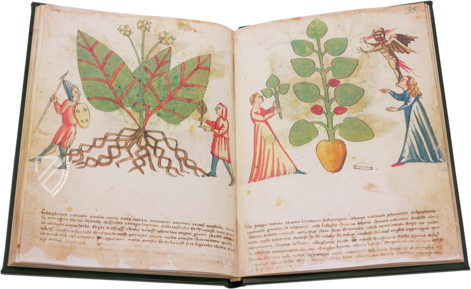Sloane Tractatus de Herbis
(3,000€ - 7,000€)
The Tractatus de Herbis is a polyglot lexicon of medieval herbal medicine that originates from Italy ca. 1440. It contains every medicinal plant, mineral, and animal part used during the Middle Ages with their terms in various languages and is illustrated with colorful miniatures on each page numbering nearly 500 in total. The inclusion of names from various languages was meant to avoid any confusion between plants, which was common in part due to the wide local variations in their names. These miniatures adorning the neatly written passages inserted among them are characterized by their charming figures and incredible color palette including bright sumptuous reds and subtle variations of green. The manuscript is a splendid specimen of Italian Gothic illumination and a wonderful example of attempts at standardization in medieval medicine.
Sloane Tractatus de Herbis
The Tractatus de Herbis, a treatise about the healing plants of the Middle Ages, is presented in one of the legendary splendid codices of the British Library, the oldest library in England. It contains descriptions of the various healing plants that were used for the healing of illnesses in the Middle Ages. The corresponding pictures of the illuminated manuscript make it an incomparably charming work for every art-lover. The stylish Gothic book adornment leads to the conclusion that the manuscript was produced in Italy in the 15th century.
Botany of the Middle Ages
The medieval culture was characterized by a variety of societal influences from across the world. The medicine of the Middle Ages was based on findings by Latin, Arab, Byzantine, and other scholars from the most remote regions of the world. These findings were brought together and translated into the world language of Greek, in order to make them universally accessible. Medical remedies were mostly produced on the basis of animal poisons and floral or mineral substances. Since the terms for plants varied widely worldwide, precise lexica of plants for guidance were made. These lexica contained pictures of all medicinal plants, described their effects and applications, and were listed with their term in all common languages. The present codex is the most popular work of this type.
Colorful Design
The medicinal handbook was furnished with a variety of colorful miniatures. The pictures serve for the identification and differentiation of the known plants. In the case of disease it was very important to apply the correct remedy for the treatment of the illness. Otherwise, it contained many plant-based poisons that in those days could easily cause death, as medieval medicine was still far from knowing an anecdote for each poison. Alongside the practical applications of the pictures, these account for the incomparable artistic charm of the lexicon. The miniatures not only show different plants, but are also adorned with high-quality depictions of animals and people. Each page of the work is adorned with a picture and all of the pictures show a bright palette of lively colors.
Codicology
- Alternative Titles
- Tratado de plantas medicinales
Tractatus de Herbis
Abhandlung über Heilpflanzen - Sloane 4016
Tractatus de Herbis - Sloane 4016 - Size / Format
- 218 pages / 38.0 × 26.5 cm
- Origin
- Italy
- Date
- 1440
- Epochs
- Style
- Language
- Script
- Gothic Textura Semiquadrata
- Illustrations
- All 218 pages are illuminated
- Previous Owners
- Nicholas Joseph Foucault
Hans Sloane
Sloane Tractatus de Herbis
Asinus
Donkeys have been used as working animals for at least 5,000 years and were very important as beasts of burden during the Middle Ages. They range in size greatly with smaller breeds weighing as little as 80 kg (180 lbs.) while larger ones can weigh in excess of 480 kg (1,060 lbs.) and can be twice as tall as other donkeys. These famously stubborn working animals were ridden by clergymen as a sign of their piety and were also an important source of parchment for making manuscripts.

Sloane Tractatus de Herbis
Eagle, Tree, and Spider
Beginning at the top, we see a proud eagle posed as though for a coat of arms with its wings outstretched and its tongue sticking out from its open beak. Its feet and talons are exaggerated in size in order to demonstrate them to the beholder. Below, there is a perfectly round spider web with a six-legged insect, which is either the spider’s prey or the artist simply neglected two of the spider’s legs.
A lollipop-shaped tree with a long slender trunk, most likely an orange tree, takes up most of the page and features a fine variety of green shades. Large distinct leaves are rendered in the yellowish-green of new growth while the rest of the tree is Kelly green. At the base, it is drawn as though the tree is standing on a valley floor.

#1 Tratado de plantas medicinales
Language: Spanish
(3,000€ - 7,000€)
- Treatises / Secular Books
- Apocalypses / Beatus
- Astronomy / Astrology
- Bestiaries
- Bibles / Gospels
- Chronicles / History / Law
- Geography / Maps
- Saints' Lives
- Islam / Oriental
- Judaism / Hebrew
- Single Leaf Collections
- Leonardo da Vinci
- Literature / Poetry
- Liturgical Manuscripts
- Medicine / Botany / Alchemy
- Music
- Mythology / Prophecies
- Psalters
- Other Religious Books
- Games / Hunting
- Private Devotion Books
- Other Genres
- Afghanistan
- Armenia
- Austria
- Belgium
- Colombia
- Croatia
- Cyprus
- Czech Republic
- Denmark
- Egypt
- Ethiopia
- France
- Germany
- Greece
- Hungary
- India
- Iran
- Iraq
- Israel
- Italy
- Japan
- Lebanon
- Luxembourg
- Mexico
- Morocco
- Netherlands
- Palestine
- Peru
- Poland
- Portugal
- Russia
- Serbia
- Spain
- Sri Lanka
- Sweden
- Switzerland
- Syria
- Turkey
- Ukraine
- United Kingdom
- United States
- Uzbekistan
- Aboca Museum
- Ajuntament de Valencia
- Akademie Verlag
- Akademische Druck- u. Verlagsanstalt (ADEVA)
- Aldo Ausilio Editore - Bottega d’Erasmo
- Alecto Historical Editions
- Alkuin Verlag
- Almqvist & Wiksell
- Amilcare Pizzi
- Andreas & Andreas Verlagsbuchhandlung
- Archa 90
- Archiv Verlag
- Archivi Edizioni
- Arnold Verlag
- ARS
- Ars Magna
- ArtCodex
- AyN Ediciones
- Azimuth Editions
- Badenia Verlag
- Bärenreiter-Verlag
- Belser Verlag
- Belser Verlag / WK Wertkontor
- Benziger Verlag
- Bernardinum Wydawnictwo
- BiblioGemma
- Biblioteca Apostolica Vaticana (Vaticanstadt, Vaticanstadt)
- Bibliotheca Palatina Faksimile Verlag
- Bibliotheca Rara
- Boydell & Brewer
- Bramante Edizioni
- Bredius Genootschap
- Brepols Publishers
- British Library
- C. Weckesser
- Caixa Catalunya
- Canesi
- CAPSA, Ars Scriptoria
- Caratzas Brothers, Publishers
- Carus Verlag
- Casamassima Libri
- Chavane Verlag
- Christian Brandstätter Verlag
- Circulo Cientifico
- Club Bibliófilo Versol
- Club du Livre
- CM Editores
- Collegium Graphicum
- Collezione Apocrifa Da Vinci
- Comissão Nacional para as Comemorações dos Descobrimentos Portugueses
- Coron Verlag
- Corvina
- CTHS
- D. S. Brewer
- Damon
- De Agostini/UTET
- De Nederlandsche Boekhandel
- De Schutter
- Deuschle & Stemmle
- Deutscher Verlag für Kunstwissenschaft
- DIAMM
- Droz
- E. Schreiber Graphische Kunstanstalten
- Ediciones Boreal
- Ediciones Grial
- Ediclube
- Edições Inapa
- Edilan
- Editalia
- Edition Deuschle
- Edition Georg Popp
- Edition Leipzig
- Edition Libri Illustri
- Editiones Reales Sitios S. L.
- Éditions de l'Oiseau Lyre
- Editions Medicina Rara
- Editorial Casariego
- Editorial Mintzoa
- Editrice Antenore
- Editrice Velar
- Edizioni Edison
- Egeria, S.L.
- Eikon Editores
- Electa
- Emery Walker Limited
- Enciclopèdia Catalana
- Eos-Verlag
- Ephesus Publishing
- Ernst Battenberg
- Eugrammia Press
- Extraordinary Editions
- Fackelverlag
- Facsimila Art & Edition
- Facsimile Editions Ltd.
- Facsimilia Art & Edition Ebert KG
- Faksimile Verlag
- Feuermann Verlag
- Folger Shakespeare Library
- Franco Cosimo Panini Editore
- Friedrich Wittig Verlag
- Fundación Hullera Vasco-Leonesa
- G. Braziller
- Gabriele Mazzotta Editore
- Gebr. Mann Verlag
- Gesellschaft für graphische Industrie
- Getty Research Institute
- Giovanni Domenico de Rossi
- Giunti Editore
- Graffiti
- Grafica European Center of Fine Arts
- Guido Pressler
- Guillermo Blazquez
- Gustav Kiepenheuer
- H. N. Abrams
- Harrassowitz
- Helikon
- Hendrickson Publishers
- Henning Oppermann
- Herder Verlag
- Hes & De Graaf Publishers
- Hoepli
- Holbein-Verlag
- Hortus Deliciarum
- Houghton Library
- Hugo Schmidt Verlag
- Idion Verlag
- Il Bulino, edizioni d'arte
- ILte
- Imago
- Insel Verlag
- Instituto Nacional de Antropología e Historia
- Istituto dell'Enciclopedia Italiana - Treccani
- Istituto Ellenico di Studi Bizantini e Postbizantini
- Istituto Geografico De Agostini
- Istituto Poligrafico e Zecca dello Stato
- Italarte Art Establishments
- J. Thorbecke
- Jan Thorbecke Verlag
- Johnson Reprint Corporation
- Josef Stocker
- Josef Stocker-Schmid
- Jugoslavija
- Karl W. Hiersemann
- Kasper Straube
- Kaydeda Ediciones
- Kindler Verlag / Coron Verlag
- Kodansha International Ltd.
- Konrad Kölbl Verlag
- Kurt Wolff Verlag
- La Liberia dello Stato
- La Linea Editrice
- La Meta Editore
- Lambert Schneider
- Landeskreditbank Baden-Württemberg
- Leo S. Olschki
- Les Incunables
- Library of Congress
- Libreria Musicale Italiana
- Lichtdruck
- Lito Immagine Editore
- Lumen Artis
- Lund Humphries
- M. Moleiro Editor
- Maison des Sciences de l'homme et de la société de Poitiers
- Manuscriptum
- Martinus Nijhoff
- Maruzen-Yushodo Co. Ltd.
- MASA
- McGraw-Hill
- Militos
- Millennium Liber
- Müller & Schindler
- Nahar and Steimatzky
- National Library of Wales
- Neri Pozza
- Nova Charta
- Oceanum Verlag
- Odeon
- Orbis Mediaevalis
- Orbis Pictus
- Österreichische Staatsdruckerei
- Oxford University Press
- Pageant Books
- Parzellers Buchverlag
- Patrimonio Ediciones
- Pattloch Verlag
- PIAF
- Pieper Verlag
- Plon-Nourrit et cie
- Prestel Verlag
- Princeton University Press
- Prisma Verlag
- Priuli & Verlucca, editori
- Pro Sport Verlag
- Propyläen Verlag
- Pytheas Books
- Quaternio Verlag Luzern
- Reales Sitios
- Recht-Verlag
- Reichert Verlag
- Reichsdruckerei
- Riehn & Reusch
- Roberto Vattori Editore
- Rosenkilde and Bagger
- Roxburghe Club
- Salerno Editrice
- Sarajevo Svjetlost
- Schöck ArtPrint Kft.
- Scolar Press
- Scrinium
- Scripta Maneant
- Scriptorium
- Siloé, arte y bibliofilia
- SISMEL - Edizioni del Galluzzo
- Sociedad Mexicana de Antropología
- Société des Bibliophiles & Iconophiles de Belgique
- Soncin Publishing
- Sorli Ediciones
- Stainer and Bell
- Studer
- Styria Verlag
- Sumptibus Pragopress
- Szegedi Tudomànyegyetem
- Taberna Libraria
- Tarshish Books
- Taschen
- Tempus Libri
- Testimonio Compañía Editorial
- Thames and Hudson
- The Clear Vue Publishing Partnership Limited
- The Facsimile Codex
- The Folio Society
- The Marquess of Normanby
- The Richard III and Yorkist History Trust
- Tip.Le.Co
- TouchArt
- TREC Publishing House
- TRI Publishing Co.
- Trident Editore
- Typis Regiae Officinae Polygraphicae
- Union Verlag Berlin
- Universidad de Granada
- University of California Press
- University of Chicago Press
- Urs Graf
- Vallecchi
- Van Wijnen
- VCH, Acta Humaniora
- VDI Verlag
- VEB Deutscher Verlag für Musik
- Verlag Anton Pustet / Andreas Verlag
- Verlag Bibliophile Drucke Josef Stocker
- Verlag der Münchner Drucke
- Verlag für Regionalgeschichte
- Verlag Styria
- Vicent Garcia Editores
- W. Turnowsky
- Waanders Printers
- Wiener Mechitharisten-Congregation (Wien, Österreich)
- Wissenschaftliche Buchgesellschaft
- Wydawnictwo Dolnoslaskie
- Xuntanza Editorial
- Zakład Narodowy
- Zollikofer AG

